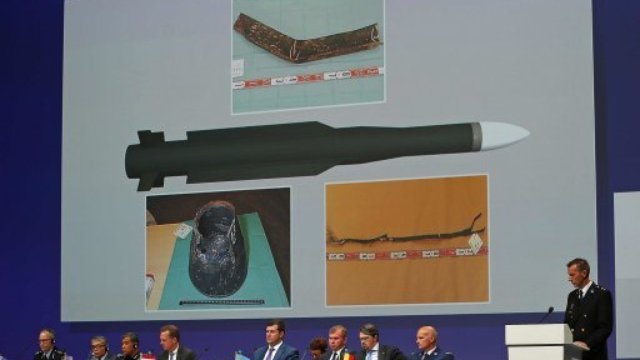MH17 Shot Down By Missile Fired From Ukraine
28 September 2016, 15:27 | Updated: 28 September 2016, 15:36

An international investigation's found the Malaysia Airlines flight MH17 was definitely shot down from the ground - by a Buk missile moved into Ukraine from Russia.
Head of the Dutch police investigation, Wilbert Pualissen said:
"Based on the criminal investigation, we have concluded that flight MH17 was downed by a Buk missile of the series 9M83, that came from the territory of the Russian Federation."
"Our investigation has shown that the location from where the BUK was fired was in the hands of the Russian separatists."
He added that after the plane had been hit, the missile launcher "was taken back to Russia".
Investigators said the missile was fired from the village of Pervomaysk.
The Boeing 777 was hit during a flight between Amsterdam and Kuala Lumpur on 17 July 2014, killing all 298 people on board, most of them Dutch citizens.
The aircraft fell apart in mid air, spreading wreckage over several miles of Ukraine.
Among those killed were Newcastle United fans Liam Sweeney and John Alder, who were traveling to New Zealand to see their beloved team play in a pre-season friendly.
Speaking to Capital ahead of the release of the report, Liam's dad Barry said he hoped this fresh investigation would help provide answers to him and the families of the others who were killed.
The report, from a team of international prosecutors, said it was unclear whether soldiers had been ordered to fire the missile, or had acted independently.
Any possibility that MH17 was brought down by another aircraft has been ruled out.
The team said it had found 100 persons of interest, but individual suspects had not been formally identified.
However, an investigator said there was a "realistic chance" the culprits would be prosecuted.
Russia disagreed with the findings. Kremlin spokesman Dmitry Peskov said:
"First-hand radar data identified all flying objects which could have been launched or were in the air over the territory controlled by rebels at that moment."
"The data are clear-cut ... there is no rocket. If there was a rocket, it could only have been fired from elsewhere."
The investigation team said it had not gained access to new Russian radar images.
One of the investigators declined to comment on possible Russian involvement.
The maker of the Buk missile said the investigation's findings were not backed by technical evidence.
The Russian foreign ministry described the investigation as "biased and politically motivated", adding that its findings were "dreamt up".
It also claimed that Moscow had been prevented from playing a full part in the probe, alleging that investigators had allowed Ukraine to "fabricate evidence" and turn the case to "its advantage".
Moscow has suggested the plane was brought down by the Ukrainian military.
But in a statement, the Ukrainian foreign ministry said the new findings should put an end to alleged attempts by Russia to discredit investigators' work by using "fabricated" information.
It added that the investigation was "more proof" of Russia's "direct complicity" in the downing of the airliner.
Two hundred witnesses were interviewed, and half a million videos and photographs viewed.
Some 150,000 intercepted phone calls were listened to.
The investigation team was drawn from the Netherlands, Australia, Belgium, Malaysia and Ukraine.
Last year, another investigation by the Dutch Safety Board also found the plane was hit by a Buk surface to air missile, a type only made by state-controlled Russian firm Almaz-Antey.
The weapons company said the model was an old one and was no longer used by Russia.
The board did not touch on which side was likely to be responsible for launching the missile but many, including Ukrainian officials and the West, blame Russian fighters and Russian president Vladimir Putin.
In May last year, families of 33 of the victims from Australia, Malaysia and New Zealand, launched legal action against the Russian Federation and Mr Putin.
The incident also played a major part in the imposition of European Union and US sanctions on Russia over the conflict in Ukraine.






